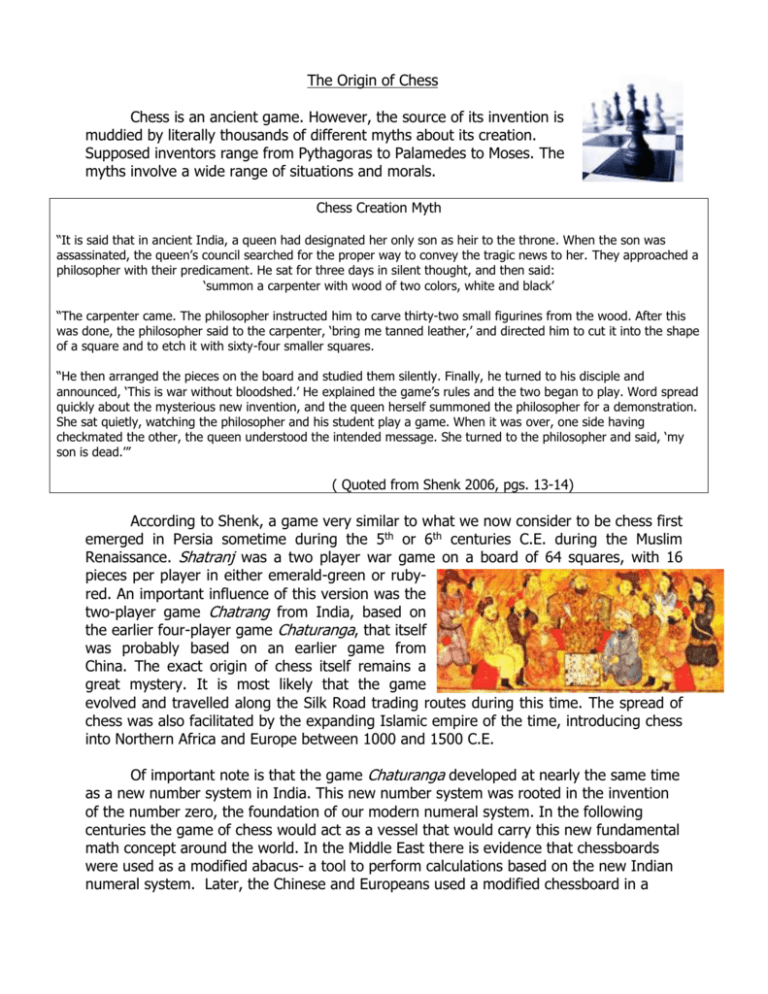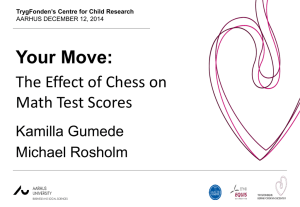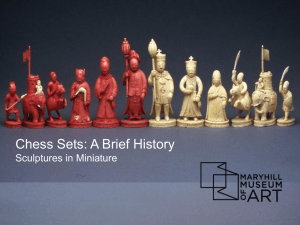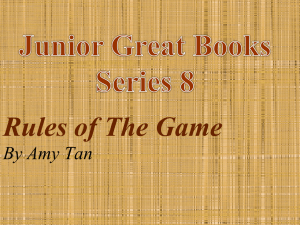The History of Chess
advertisement

The Origin of Chess Chess is an ancient game. However, the source of its invention is muddied by literally thousands of different myths about its creation. Supposed inventors range from Pythagoras to Palamedes to Moses. The myths involve a wide range of situations and morals. Chess Creation Myth “It is said that in ancient India, a queen had designated her only son as heir to the throne. When the son was assassinated, the queen’s council searched for the proper way to convey the tragic news to her. They approached a philosopher with their predicament. He sat for three days in silent thought, and then said: ‘summon a carpenter with wood of two colors, white and black’ “The carpenter came. The philosopher instructed him to carve thirty-two small figurines from the wood. After this was done, the philosopher said to the carpenter, ‘bring me tanned leather,’ and directed him to cut it into the shape of a square and to etch it with sixty-four smaller squares. “He then arranged the pieces on the board and studied them silently. Finally, he turned to his disciple and announced, ‘This is war without bloodshed.’ He explained the game’s rules and the two began to play. Word spread quickly about the mysterious new invention, and the queen herself summoned the philosopher for a demonstration. She sat quietly, watching the philosopher and his student play a game. When it was over, one side having checkmated the other, the queen understood the intended message. She turned to the philosopher and said, ‘my son is dead.’” ( Quoted from Shenk 2006, pgs. 13-14) According to Shenk, a game very similar to what we now consider to be chess first emerged in Persia sometime during the 5th or 6th centuries C.E. during the Muslim Renaissance. Shatranj was a two player war game on a board of 64 squares, with 16 pieces per player in either emerald-green or rubyred. An important influence of this version was the two-player game Chatrang from India, based on the earlier four-player game Chaturanga, that itself was probably based on an earlier game from China. The exact origin of chess itself remains a great mystery. It is most likely that the game evolved and travelled along the Silk Road trading routes during this time. The spread of chess was also facilitated by the expanding Islamic empire of the time, introducing chess into Northern Africa and Europe between 1000 and 1500 C.E. Of important note is that the game Chaturanga developed at nearly the same time as a new number system in India. This new number system was rooted in the invention of the number zero, the foundation of our modern numeral system. In the following centuries the game of chess would act as a vessel that would carry this new fundamental math concept around the world. In the Middle East there is evidence that chessboards were used as a modified abacus- a tool to perform calculations based on the new Indian numeral system. Later, the Chinese and Europeans used a modified chessboard in a similar way for accounting. By the late 12th century C.E. chess was a game many considered to be closely related to the study of geometry as well. Chess acted as a visual representation of a variety of mathematical systems and ideas. The game of chess as we now recognize it in the West today was developed through modifications to the game as it spread around Europe. Pieces with foreign cultural references were replaced with images more familiar to Europeans. For example, the two Elephants per army in the Persian version of the game were replaced by the more culturally familiar Bishop pieces in Europe. By the 12th century C.E. chess had become a common and familiar game in Europe. It even became one of the 7 essential skills of a medieval knight. By the 15th and 16th centuries chess had developed into the game we recognize today; faster paced and with more universally recognized Ancient & Modern 'Knights' rules than its preceding variations. Chess remained an important cultural icon during the following centuries, and the Industrial Revolution of the 1800’s saw chess arise again- this time with the newly wealthy middle class, especially in England where London now rivalled Paris as the chess capital of the world. Competitive chess also reached new heights in the 19th century. The first international tournament was held in London 1951, and the first official World Champion, Wilhelm Steinitz, was recognized in 1886. ----------------------------------------------------------------------------------------------------------Chess as an Obsession Chess has remained a cultural icon in Europe through the centuries, and has even turned into obsession for some. The famous French artist Marcel Duchamp (known most famously for his Dada-inspired “Fountain” installation) is an example of someone who became totally consumed by the game of chess. By the age of 30, Duchamp had produced works of art that would make him one of the most influential artists of the 20th century; but at a time when his career was flourishing, Duchamp turned all his focus to chess, obsessed with playing the game. The obsession began in earnest in his late twenties and by the time he was in his early thirties (in the early 1920’s) he had ceased producing art altogether. All his Duchamp, 1952 time was devoted to the game of chess. Duchamp is hardly the only example; there are numerous examples of professional players being institutionalized, suffering breakdowns and paranoia, and committing suicide. They are the victims of a dangerously attractive game. ----------------------------------------------------------------------------------------------------------References Shenk, David. (2006). The Immortal Game. New York: Random House, Inc. Murray, H.J.R. (1963). A Short History of Chess. Oxford: The Clarendon Press.








